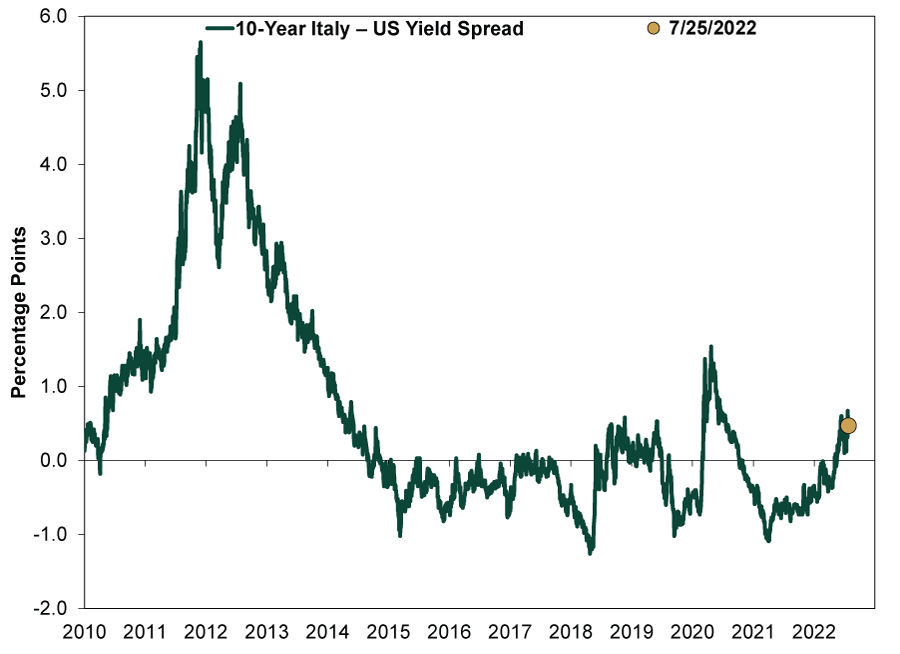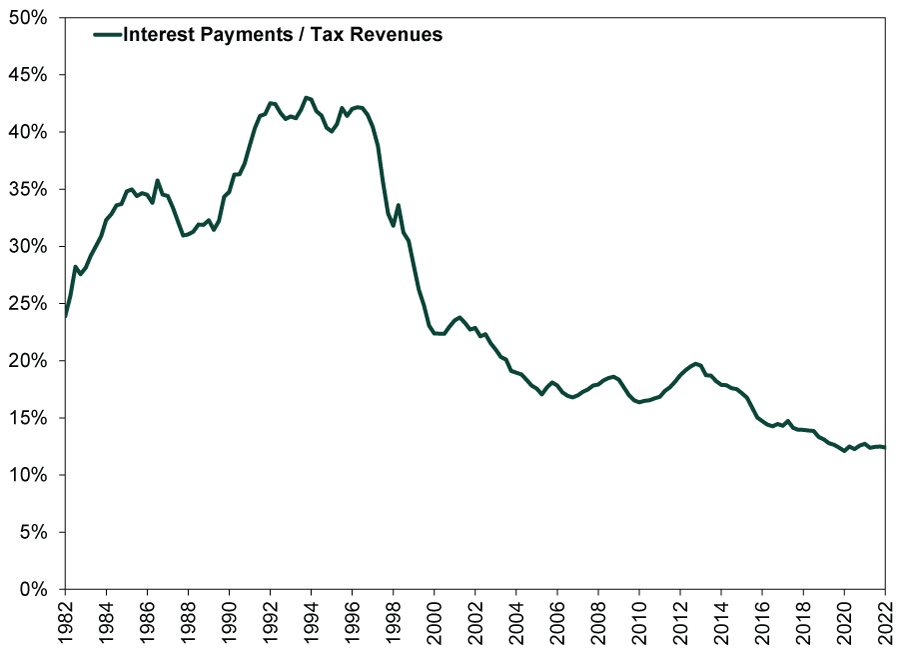Personal Wealth Management / Market Analysis
Italy Can Still Service Its Debts Easily
Political uncertainty doesn’t change Italy’s debt affordability.
Editors’ note: MarketMinder is nonpartisan, preferring no party nor any politician. Our analysis aims solely to assess political developments’ potential market impact.
It was supposedly a double whammy for Italian bond markets Thursday after (now caretaker) Prime Minister Mario Draghi resigned and the ECB hiked rates half a percentage point (ppt). Italy’s 10-year yield rose 0.22 ppt on the day to 3.58%—its highest since summer 2020, when credit spreads spiked during initial pandemic lockdowns, before falling back Friday. (Exhibit 1) Pundits now say a financial crisis is brewing, but we don’t think one looks any more likely than last month.
Exhibit 1: The 10-Year Italian-US Credit Spread Widened Some
Source: FactSet, as of 7/25/2022. 10-year Italian BTP yield minus 10-year US Treasury yield, 1/1/2010 – 7/25/2022.
While widening credit spreads can point to possible financial stress, they don’t automatically signal imminent default. Italy happens to be very familiar with this. In April 2020, Italy’s 10-year yield spread against global benchmark US Treasurys widened to 1.54 ppts. During the eurozone’s debt crisis, it hit 5.65 ppts. In neither case did Italy default. (Note: We use US Treasurys as the benchmark—rather than, say, German bunds—because of America’s global financial safe-haven status. In an existential euro crisis, capital probably wouldn’t flee to another eurozone member.)
Italian bond yields’ latest move looks mostly sentiment driven to us—fundamentally, Italy can easily service its debts. Exhibit 2 shows Italy’s interest payments are about 12% of tax revenues, well below the 1990s’ 40%+ rates. As Italy didn’t default three decades ago, we doubt it will now. Pundits still fret rising yields will make Italy’s debts increasingly unaffordable, but they likely have a long wait. Italian bonds’ weighted-average maturity is over seven years.[i] From today’s 3.27% 10-year rate—far below early-1990s’ low-teens—yields would have to skyrocket and stay elevated several years for debt payments to balloon unsustainably.[ii]
Exhibit 2: Italy’s Increasingly Affordable Debt Load
Source: FactSet, as of 7/25/2022. Italian interest payments as a percent of tax revenues, Q1 1982 – Q1 2022.
How likely is that? In the wake of Italy’s centrist “technocratic” coalition’s demise, fears have grown that a new government led by the far-right Brothers of Italy—who presently lead polls—won’t adhere to reforms unlocking EU pandemic relief funds, possibly jeopardizing the fiscal outlook. But where the next government falls on the political spectrum isn’t the most relevant question for investors. It is: Can it push through radical legislation?
With two months until September 25’s vote, election outcomes aren’t certain. Polls aren’t predictive—and they can change. Also, after voters approved constitutional reforms via referendum in 2020, this election will be for far fewer seats in Parliament. These reforms cut lower-house seats to 400 from 630 and upper-house seats to 200 from 315. Theoretically, this may make it easier to form a majority, but they have yet to run the experiment. How it all shakes out is anyone’s guess. At this point, the government’s future make up isn’t knowable. What it can accomplish, even less so.
We do know Italy has seen similar political upheaval before—without much change to its financial standing. Fears of a populist government takeover became reality in 2018 when the antiestablishment Five Star Movement came to power with the nationalist League’s support. Look back to Exhibit 1: That is when Italian bond yields “spiked” (to parity with US Treasurys). But with barely any overlap in their ideology or objectives, gridlock ensued. They accomplished little, and the government was short-lived. Subsequent governments haven’t proved much better, and while the next might be more ideologically aligned, that doesn’t ensure radical policies’ passage. On both the right and left sides of the spectrum, there are pro- and anti-euro factions, not to mention other internal differences. As in the rest of the developed world, it wouldn’t surprise us if gridlock’s reign continues in Italy’s fractured political landscape. In any case, we will be watching.
As for the ECB’s half-point hike to all of 0%, it wasn’t exactly shocking, considering ECB President Christine Lagarde had teed it up earlier in the week. It also follows other major central banks’ (save Japan’s) rate hikes. Possibly more relevant for Italy: the ECB’s new Transmission Protection Instrument (TPI)—the eurozone “anti-fragmentation” defense it has been floating for months. The TPI allows targeted ECB bond buying “to counter unwarranted, disorderly market dynamics that pose a serious threat to the transmission of monetary policy across the euro area.”[iii] This is supposed to prevent more indebted eurozone members’ borrowing costs from spiking. As the ECB’s thinking goes, its rate normalization path depends on its monetary policy being appropriate for all member countries. In more ECB-speak:
“Subject to fulfilling established criteria, the Eurosystem will be able to make secondary market purchases of securities issued in jurisdictions experiencing a deterioration in financing conditions not warranted by country-specific fundamentals, to counter risks to the transmission mechanism to the extent necessary. The scale of TPI purchases would depend on the severity of the risks facing monetary policy transmission. Purchases are not restricted ex ante.”[iv]
In our view, this just further formalizes Draghi’s 2012 promise to do “whatever it takes” to back the euro when he was ECB president. But as the ECB is the eurozone’s lender of last resort anyway, we don’t see this as particularly necessary—much less for Italy, which is more than capable of paying its way. The long-running notion that only the ECB is keeping Italian debt affordable is false. In December 2018, after the ECB stopped asset purchases and ended quantitative easing (QE), Italian 10-year bond yields fell below equivalent maturity US Treasurys without ECB “support”—until QE’s March 2020 restart amid pandemic lockdowns.
Note, too, that even with the sentiment-fueled spike in yields this year, Italy’s Treasury is still refinancing a lot of its maturing debt at a discount. 10-year Italian bonds coming due now carry coupons around 5%. Current 10-year yields are below that, meaning Italy’s actual funding costs are continuing to decrease. For investors, we think all the hubbub over Italian debt is just another sentiment brick in the wall of worry. However the next few months’ political chips may fall, Italy’s underlying economic reality is better than most perceive.
[i] Source: Italian Department of the Treasury, as of 7/25/2022. Weighted average life of government bonds, June 2022.
[ii] Source: FactSet, as of 7/25/2022. 10-year Italian bond yield, 7/25/2022.
[iii] “Monetary Policy Decisions,” Staff, ECB, 7/21/2022.
[iv] “The Transmission Protection Instrument,” Staff, ECB, 7/21/2022.
If you would like to contact the editors responsible for this article, please message MarketMinder directly.
*The content contained in this article represents only the opinions and viewpoints of the Fisher Investments editorial staff.
Get a weekly roundup of our market insights
Sign up for our weekly e-mail newsletter.

You Imagine Your Future. We Help You Get There.
Are you ready to start your journey to a better financial future?

Where Might the Market Go Next?
Confidently tackle the market’s ups and downs with independent research and analysis that tells you where we think stocks are headed—and why.







